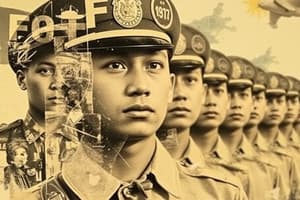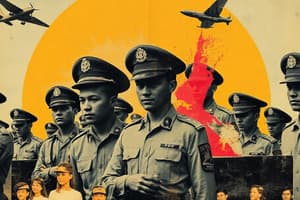Podcast
Questions and Answers
What is the primary mission of the Reserve Officer Training Corps (ROTC)?
What is the primary mission of the Reserve Officer Training Corps (ROTC)?
- To train and develop college students. (correct)
- To provide vocational training to college students.
- To prepare students for international diplomacy.
- To enhance physical fitness in students.
Which act established the National Service Training Program (NSTP) for tertiary students?
Which act established the National Service Training Program (NSTP) for tertiary students?
- Commonwealth Act No. 1
- Republic Act No. 7077
- Republic Act No. 8498
- Republic Act No. 9163 (correct)
Which of the following is not one of the three program components of the NSTP?
Which of the following is not one of the three program components of the NSTP?
- Literacy Training Service (LTS)
- Reserve Officer Training Corps (ROTC)
- Leadership Skills Development (LSD) (correct)
- Civil Welfare Training Service (CWTS)
What does military courtesy primarily emphasize?
What does military courtesy primarily emphasize?
When is it not required to salute in a military context?
When is it not required to salute in a military context?
What is the recognition distance when saluting?
What is the recognition distance when saluting?
Which statement best defines military discipline?
Which statement best defines military discipline?
What is a critical aspect of military discipline mentioned in the content?
What is a critical aspect of military discipline mentioned in the content?
What is essential for the use of punishment to be considered judicious?
What is essential for the use of punishment to be considered judicious?
Which aspect of military history refers to the skill of exercising military command?
Which aspect of military history refers to the skill of exercising military command?
What event did Datu Lapu-lapu famously lead against foreign invaders?
What event did Datu Lapu-lapu famously lead against foreign invaders?
Which thread of continuity in military history focuses on the actions of governments that affect warfare?
Which thread of continuity in military history focuses on the actions of governments that affect warfare?
What is the primary function of the Armed Forces of the Philippines (AFP)?
What is the primary function of the Armed Forces of the Philippines (AFP)?
What was one of the main reasons for the revolts against Spanish colonial government in the Philippines?
What was one of the main reasons for the revolts against Spanish colonial government in the Philippines?
What kind of soldier was prevalent in the pre-colonial Philippines?
What kind of soldier was prevalent in the pre-colonial Philippines?
Which of the following is NOT a thread of continuity in military history?
Which of the following is NOT a thread of continuity in military history?
Study Notes
ROTC
- The Reserve Officers' Training Corps (ROTC) is a military training program for tertiary level students in the Philippines.
- It is institutionalized under Republic Act No. 7077 (AFP Reservist Act).
- The ROTC's mission is to train and develop college students for military service.
- The ROTC program aims to enhance civic consciousness and defense preparedness in youth.
Key Legislations
- Commonwealth Act No. 1, the National Defense Act, was enacted in 1935.
- Republic Act No. 7707, the AFP Reservist Act, was enacted in 1991.
- Republic Act No. 9163, the National Service Training Program, was enacted in 2001.
NSTP
- The National Service Training Program (NSTP) is a program for tertiary level students intended to enhance civic consciousness and defense preparedness.
- NSTP has three components:
- ROTC
- Literacy Training Service (LTS) - trains students to become teachers.
- Civic Welfare Training Service (CWTS) - involves activities that contribute to the general welfare.
Military Courtesy
- Military courtesy is a written/officially prescribed code of deportment for members of the military establishment.
- It involves good manners with other people and smooth conduct in dealing with them.
- The salute is an important form of military courtesy used to show honor to the national anthem and colors.
Military Discipline
- Military discipline refers to the willingness to accept conviction.
- It is essential for:
- Teamwork
- Obligation to one's self, unit, and commander
- Ensuring unit efficiency in battle
- A climate of discipline is created through training.
- Punishments should be:
- Used only on the guilty person
- Imposed promptly
- Designed to help the guilty person realize their mistake
- Appropriate for the offense.
Philippine Military History
- Military history is a humanities discipline that records armed conflict in the history of humanity.
Ten Threads of Continuity in Military History
- Military Theory: a body of ideas about war.
- Military Doctrines: generally accepted practices that govern military organization.
- Military Professionalism: the attitude or state of mind of a military professional.
- Generalship: the skill and practice related to military command.
- Strategy: Preparation for and the waging (engagement) of war.
- Tactics: Preparation and actual conduct of combat in the battlefield.
- Logistics and Administration: Supply, transportation, evacuation, hospitalization, service, and personnel management.
- Technology: The application of war science to warfare.
- Political Factors: Actions of government that affect warfare.
- Social Factors: Human relationships that affect warfare.
- Economic Factors: Elements that affect warfare, such as production, distribution & consumption of a state’s resources.
Milestones of Philippine Military History
- Pre-Colonial Period (1521):
- Citizen Soldiers: Allegiance to personal leaders.
- Weapons used included kris, bolo, kampilan, and bangkaw.
- Discovery of the Philippines (Search for Spices)
- Battle of Mactan:
- Datu Lapu-lapu killed 1,500 native warriors.
- Legaspi Urdaneta (1565):
- Miguel Lopez de Legaspi (Spanish explorer) and Andres Bonifacio.
- Francisco Dagohoy Rebellion: against the Spanish Colonial government in Bohol (1744-1828).
- The rebellion was categorized into three types:
- Personal Religious
- Resistance to Spanish-imposed institutions
- Land Problems.
- The Spaniards realized that they needed Filipinos to have power.
AFP Organization
- The Armed Forces of the Philippines (AFP) functions to:
- Uphold national sovereignty
- Support the constitution
- Defend the territory
- Promote national interest
- Organize, develop and deploy its forces
- Support the national government in nation building
- Perform other tasks assigned by the President.
Command Authority
- President of the Republic of the Philippines - Commander-in-Chief.
- ... (incomplete)
Studying That Suits You
Use AI to generate personalized quizzes and flashcards to suit your learning preferences.
Description
This quiz explores the Reserve Officers' Training Corps (ROTC) and the National Service Training Program (NSTP) in the Philippines, focusing on their objectives, key legislations, and components. It highlights the importance of military training and civic consciousness among college students.




